Japan
Wood Products Prices
Dollar Exchange Rates of 10th
Mar
2022
Japan Yen 116.0
Reports From Japan
Contingency plans for
disruption of supply chains
Following Russia¡¯s invasion of Ukraine Japan has moved
to impose sanctions together with the United States,
European Union members and other nations. Trade
statistics from Japan¡¯s Ministry of Finance show that in
calendar year 2021 the value of imports from Russia rose
35% from 2020 to yen1.5 trillion. This represents close to
2% of Japan¡¯s total imports. Imports from Russia were
mainly energy resources¡ªincluding liquefied natural gas,
coal, oil and nonferrous metals.
See:
https://www.nippon.com/en/japan-data/h01266/
Japan is identifying critical imports from Russia so as to
make contingency plans for potential disruptions to supply
chains as Russia has banned some exports in retaliation
against economic sanctions. In retailiation Russia has
named countries to which exports will be halted. Japan is
among the countries indentified and Russsia has
announced timber exports to Japan will be suspended until
31 December 2022.
Russia is the largest sawnwood exporter and ranks the
seventh biggest exporter of wood products. Wood product
exports from Russia have increased rapidly in the past five
years led by sawn softwood and paper products.
See:
https://www.woodbusiness.ca/russias-invasion-of-ukrainewill-likely-halt-planned-forest-industry-investments/
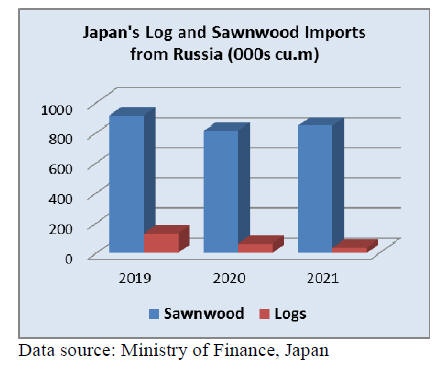
Japanese companies in Russia struggle to pay
employees
Japanese companies are assessing whether their operations
in Russia can be maintained as Japan has joined the
US and EU in blocking international financial transactions
to and from Russia. A concern is that Japanese companies
with operations in Russia may not be able pay employees.
The collapse of the rouble has made sourcing cash
extremely difficult.
According to a government statement 32 Russian and
Belarusian individuals along with 12 entities including
military-related companies were added to the list of those
facing asset freezes in Japan.
See:
https://asia.nikkei.com/Politics/Ukraine-war/Corporate-Japan-gauges-Russia-risk-as-sanctions-deepen
and
https://japantoday.com/category/politics/update1-japan-imposesmore-sanctions-on-russia-belarus-over-ukraine-invasion
also
https://www.mitsui.com/mgssi/en/report/detail/__icsFiles/afieldfile/2016/10/20/160707m_kitade_e.pdf
Business conditions
The Japanese economy in January showed a weakening of
prospects for the first time in four months. The January
fall came after a slight rise in December 2021. For the fifth
straight month the Cabinet Office maintained its
assessment that the domestic economy is "weakening".
See:
https://mainichi.jp/english/articles/20220308/p2g/00m/0bu/053000c
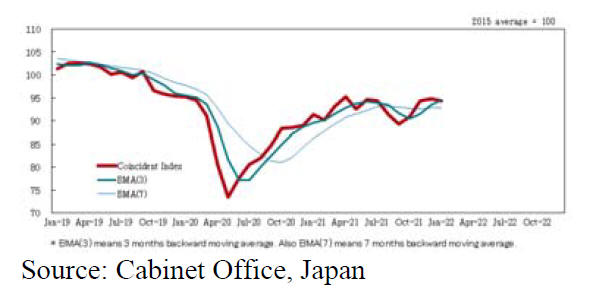
Consumer confidence down once more
Consumer confidence dropped in February for the third
consecutive month due mainly to a rise in Omicron
infections. The index provides an insight into consumer
expectations for the coming six months. An index below
50 indicates that pessimists outnumber optimists.
During the February survey many prefectures were still
under a corona semi-lockdown which limited
opportunities for consumers. The index for willingness to
purchase durable goods fell sharply in February as
consumers put off purchases.
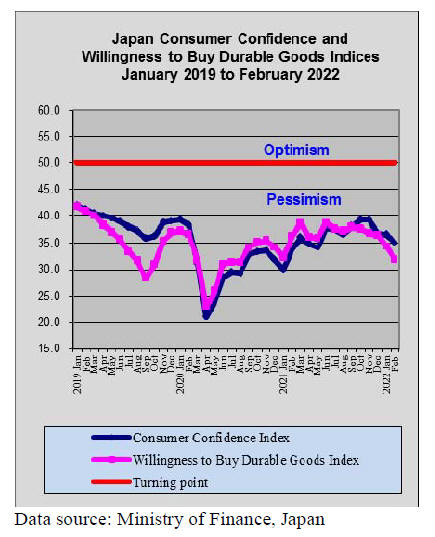
Housing
Municipalities in Japan are providing support to
Ukrainians who have fled to Japan. The Immigration
Services Agency said evacuees have a 90-day residential
visa which can be extended or replaced with a longer-term
residential status that would allow them to work in
Japan. According to the United Nations High
Commissioner for Refugees more than 2 million Ukrainian
refugees had fled the country.
Yokohama City has indicated it is ready to support people
fleeing from Ukraine. Osaka prefectural government said
it is providing Ukrainian evacuees with free
accommodation while also offering employment and
educational support. Mie and Kanagawa Prefectures are
also offering accommodation to those fleeing Ukraine.
In addition to municipalities, Japanese companies are
stepping forward. Pan Pacific International Holdings
Corp., operator of the Don Quijote discount store
chain announced it will offer housing to 100 Ukrainian
families as well as jobs.
See:
https://www.japantimes.co.jp/news/2022/03/09/national/municipalities-companies-ukraine-evacuees-support/
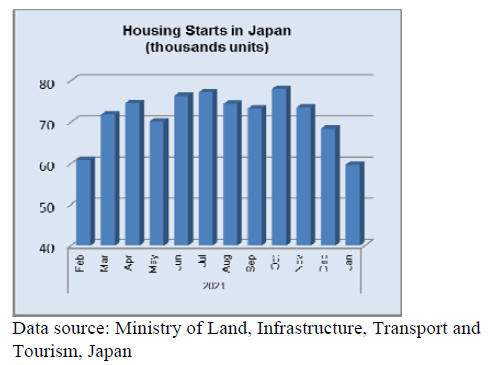
Yen purchasing power drops
The Bank for International Settlements publishes real and
nominal effective exchange rates for major currencies. The
most recent data came as a surprise as it showed that the
yen's effective exchange rate (representing purchasing
power) is now as low as it was in the early 1970s when the
yen was first floated following the collapse of the Bretton
Woods and Smithsonian systems of fixed exchange rates.
See:
https://www.bangkokpost.com/opinion/opinion/2276139/howdid-japan-become-so-cheap-

Import update
Furniture imports
The value of Japan¡¯s imports of wooden office, kitchen
and bedroom furniture all closed 2021 at a higher level
than in 2020. Remarkably, 2021 imports of wooden
bedroom furniture (HS940350) were higher than in 2019
as well as 2020.
The value of wooden office furniture imports dipped in
2020 but recovered and ended 2021 higher than in 2019.
In contrast, imports of wooden kitchen furniture in 2021
had still not recovered to 2019 levels.
 
December office furniture imports (HS
940330)
The top shipper of wooden office furniture in December
2021 was China taking a much higher market share at 75%
compared to a month earlier. The other main suppliers in
December last year were the US (8%), Poland (4%) and
Taiwan P.o.C.
Year on year the value of imports of wooden office
furniture (HS940330) rose almost 15% in December 2021
building on the steady upward trend seen over the previous
few months. Month on month the value of wooden office
furniture rose 5%.
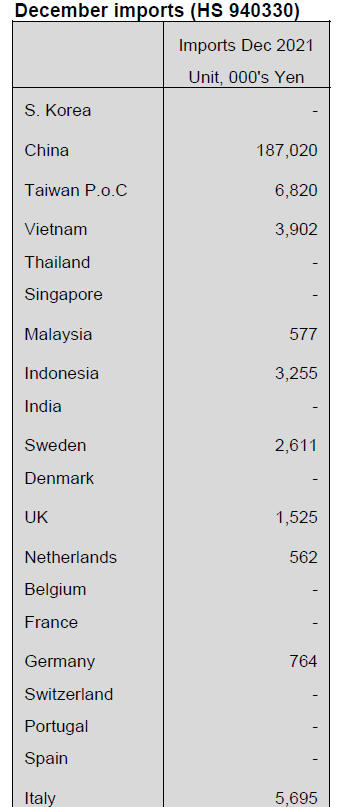 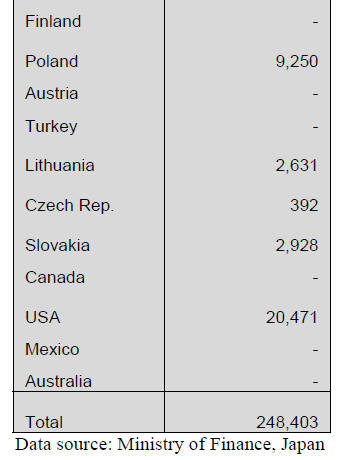
Kitchen furniture imports (HS 940340)
Following a very sharp rise in the value of wooden kitchen
furniture in November 2021 there was a 6% downward
correction in December. However, year on year December
2021 imports were some 13% higher.

Around 90% of Japan¡¯s December 2021imports of wooden
kitchen furniture came from just 3 sources; the Philippines
(51%), Vietnam (31%) and China (7%).
Bedroom furniture imports (HS 940350)
The third quarter of 2021 saw a steady increase in the
value of Japan¡¯s imports of wooden bedroom furniture
reversing the downward trend that began mid-year and
pulling overall imports for the year up above that for 2020
and even above the value of 2019 imports. The top
suppliers in terms of value in December 2021 were China
(60%) and Vietnam (28%). Shipments from both countries
were impacted by logistic problems.

When the value of imports from Malaysia (6%) and
Poland are include with those from the two top shippers
then around 95% of Japan¡¯s wooden bedroom furniture
imports have been accounted for. Year on year, December
2021 imports were 9% higher and month on month
December imports were 4% higher.
Trade news from the Japan Lumber Reports (JLR)
The Japan Lumber Reports (JLR), a subscription trade
journal published every two weeks in English, is
generously allowing the ITTO Tropical Timber Market
Report to reproduce news on the Japanese market
precisely as it appears in the JLR.
For the JLR report please see:
https://jfpj.jp/japan_lumber_reports/
Confusion by the Russian invasion
After Russia invaded Ukraine there are rising concerns as
to trade. One is payment after SWIFT excluded major
Russian banks and another is shipping. At this stage,
nothing is clear yet as to banking system.
Shipping problem is serious. The European authorities
deny transshipping containers for Russian destinations.
Large container ships unload for transshipping at
European ports like Rotterdam and Hamburg onto smaller
vessels for Russia.
There are three major ports in Russia, St. Petersburg on
Baltic Sea, Novorossiysk on Black Sea and Vladivostok in
the Far East. These three ports receive74% of all container
cargoes.
Major container shipping companies have stopped taking
orders for Russia. Also marine insurance for the Russian
ports is now categorised as war zone so that insurance
premium is extremely high so shipping companies are
refusing to call Russian ports.
It is expected there will be confusion in the wood products
trade as this is totally new experience like COVID-19
epidemic so everyone has to keep watching the changes in
the situation. Many wood product manufacturers in
Europe rely on raw materials from Russia and Ukraine. If
payment system stop the supply of wood stops.
Russian logs and lumber import in 2021
The total volume of softwood logs from Russia is about
32,000 cbms, 35.2% less than 2020.The volume of red
pine KD taruki is 505,000 cbms, 7.4% less than last year.
There was not only a decrease of volume but also serious
problems of delays of arriving to Japan in 2021.
There were three kinds of softwood logs such as larch, red
pine and whitewood, which were imported to Japan in
2020 and the volume was under 100,000 cbms. The
volume of these three kinds did not exceed in 2021.
The manufacturers, which convert larch or red pine logs to
lumber, were getting less in Japan. A ban of exporting logs
from Russia in January, 2022 had a big influence.
The exporting logs just before the ban was in
December,
2021 and the volume of larch was around 4,000 cbms. It
was around 5,600 cbms in December, 2020. The volume
of lumber was 600,000 cbms. It is straight two years.
The prices skyrocketed at the beginning of 2021 in Russia.
Red pine KD taruki was US$1,000, CIF per cbm, before
last summer. Red pine genban was US$ 700, CIF per cbm.
The supply did not increase even though the prices were
extremely high. One of reasons is that logs were exported
to China mostly.
A lack of containers caused delays of arriving to Japan.
Another reason is that much demand of wood were in all
over the world. The delays have been continuing. The
products, which were agreed to a contract in last summer,
had just arrived in February, 2022.
Imported lumber inventory at Tokyo
Imported lumber inventory at Tokyo harbor at the end of
January was 7.9% more than December with 178,000
cbms. This is three consecutive months increase.
Bulk ship of North American lumber arrived one in
December and another in January then delayed shipments
of European lumber and Russian lumber arrived one after
another.
The inventory at the end of January last year was only
71,000 cbms so now it¡¯s 2.5 times more. The arrivals
increased in December and January so the inventory
jumped up from the bottom of last November¡¯s 131,000
cbms.
By source, North America is 54,000 cbms, 2.57 times
more than a year ago. Europe is 54,000 cbms, 3.6 times
more. Russia is 33,000 cbms, 2.2 times more. China and
others are 31,000 cbms, 1.9 times more. Increase of
European lumber is conspicuous. However, compared to
two years ago, North America increased by 45.9% but
European is only 5.9% more and Russian is 3.1% more.
Bulk ships from North America were three in last
December and one in January with total volume of 37 M
cbms with December arrival of 42,000 cbms so unusually
high supply because the supplier took additional orders in
fear of log shortage in the first quarter so the first quarter
supply will drop.
Problem is that the market in Japan is becoming bearish
with heavy inventory but worldwide wood market is
recovering and the prices are climbing again. Daily
shipment volume in January was 3,610 cbms, 29.9% more
than December.
This is the highest since September 2019 so the inventory
should decrease speedily. With bearish mood, second
quarter contract volume is expected to decrease largely.
Inventory shortage may become serious in summer
months.
Price hike of softwood plywood
Plywood manufacturers in Japan announced to increase
the sales prices of softwood plywood by 100 yen to 1,700
yen per sheet on 12 mm thick 3x6 panel since March
1.Producing cost has been climbing much faster than the
manufacturers expected. Cost of cedar log and adhesive is
increasing month after month.
Log prices in the North East continue climbing as
competition with laminated lumber mills is keen and even
plywood mills outside the region are now buying logs in
the North East so cedar 4 meter log prices are now15,000
yen per cbm delivered, 1,500 yen up from last month and
larch log prices are 22,0000-25,000 yen , 2,000-3,000 yen
up from January.
Plywood mills use Russian made larch veneer but
deliveries are delayed by rough sea in winter and difficulty
of securing ship¡¯s space. Adhesive prices also continue
climbing as oil and natural gas prices are soaring so
adhesive manufacturers are likely to ask price hike further
more.
Demand for plywood is active mainly by precutting plants
so demand continues more than the production.
Precutting plants buy allocated volume even if they do not
need in fear of future supply shortage.24 mm and 28 mm
3x6 panel prices are up by 100 yen at 3,400 yen and 3,950
yen.
Of immediate concern to plywood mills is procurement of
material logs. Particularly in the North East, snow fall is
much more than normal years and log prices continue
climbing. Precutting orders are not increasing while the
plants are busy processing orders they have now. Orders
are declining in heavy snowed areas. Precutting plants
keep buying plywood in an anticipation of demand
increase in coming months and keep extra volume in
inventory.
For plywood mills not only high cost of logs but other
factors are inflating such as oil and natural gas, trucking
cost and adhesive cost so overall producing cost continues
climbing.
South Sea plywood manufacturers are struggling tight log
supply and inflating adhesive cost so they are determined
to pass higher cost onto sales prices.
In Japan, it is time to make purchase as the inventory
continues declining but offer volume by South East Asian
plywood manufacturers is very limited, about a half of
normal period so it is hard to buy what they need then the
market in Japan is uncertain so importers are hesitant to
make future purchase.
|